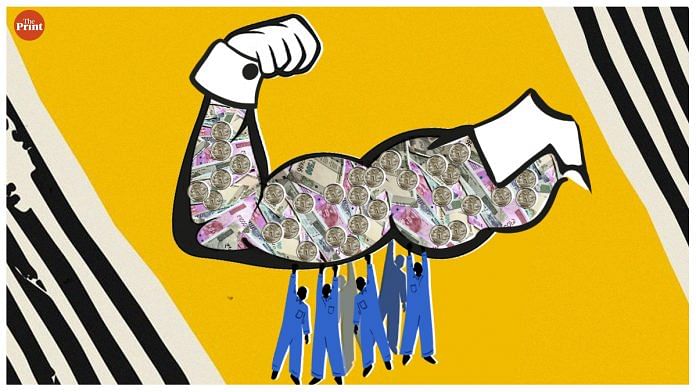At the turn of the century, in 2000-01, India’s exports of manufactured goods accounted for the bulk of the total export basket for both goods and services. Services exports were only half of manufactured exports. A decade later, in 2010-11, the export of manufactured products still accounted for the biggest chunk in India’s export basket, but its share had slipped. And by the last financial year, 2020-21, services exports ($206 billion) had virtually caught up with manufactured exports ($208 billion), in a total export basket of $498 billion. In the space of two decades, from being half of manufactured exports, services exports had drawn level.
If one looks at growth rather than the totals, the trend is starker. Services exports in the decade to 2020-21 grew by $81 billion, more than twice the growth in manufactured goods exports ($37 billion). India’s ratio of services to merchandise exports now mirrors that of the US and some other post-industrial economies that have yielded on manufacturing to China/ East Asia. Such a ratio is unique for a diversified developing economy.
This trend appears to have been reversed in the current year, with merchandise exports growing faster than services, possibly because of higher prices for petroleum goods exports. One should not expect this reversal of the trend to be sustained. India’s primary competitive advantage remains the cost of its manpower. This is clearest with the educated workforce, and underpins the country’s competitiveness in the export of software services, its strength in chip design rather than chip manufacture, and its success in exporting knowledge-based products like pharmaceuticals and speciality chemicals because they have better margins.
The competitive advantage in labour costs explains also the growing importance of agricultural exports, enabled as it is by poor returns on farming despite desperately low farm wages. It is cold comfort, but telling nevertheless, that agricultural exports too have grown much faster in the last decade (68 per cent) than manufactured exports (22 per cent).
Also read: Growth is a big help but India also needs to account for jobs, poverty, health, environment
The obvious question is why the manpower cost advantage is not reflected in the export of labour-intensive, high-volume but low-margin products like garments and shoes (items that explained East Asia’s initial successes). The answer, as everyone knows, is policy failure. There was the initial reservation of these items for small-scale industry (hence an absence of scale), rigid labour laws that prevented flexible workplace practices, incentives that rewarded capital-intensive industries, and other such. Some of these issues have been addressed, others not.
Is it too late to boost labour-intensive manufacturing for export markets? No, for China with higher labour costs still earns much more from garment exports than India. But it has become more difficult for an important reason: The rupee’s exchange rate. If India were trading in only goods, a massive deficit of about $150 billion (5 per cent of GDP) would have forced down the rupee’s value. That would have made Indian manufactured goods cheaper in export markets, and domestic production cheaper than imports. This currency correction does not happen because the deficit in the goods trade is mostly neutralised by a surplus in the trade in services. Put bluntly, white-collar success has trumped blue-collar viability.
Recognising the problem, India while negotiating to join the Regional Comprehensive Economic Partnership sought concessions on merchandise trade in exchange for opening up on services trade, but the rest of the region (influenced by China and others) didn’t bite. India then opted out, but that doesn’t make the problem disappear. Indeed the country has made life more difficult for itself by opening up more and more to external capital, whose inflow pushes up the rupee. Rewarding foreign portfolio investors has been given priority over creating domestic employment.
The resulting dollar surplus has forced the Reserve Bank of India to buy dollars that it doesn’t need, swelling foreign exchange reserves. There are limits to such action, so the rupee is likely to remain too expensive for low-margin manufactured exports to be viable, especially in India’s still-handicapped operating environment. It is a small relief that, in the latest Budget, the government did not open wider the bond market to international capital, as many wanted. That would have made the problem worse.
By special arrangement with Business Standard
Also read: India must do homework before commercial contracts, no room for fuzziness in art of the deal






